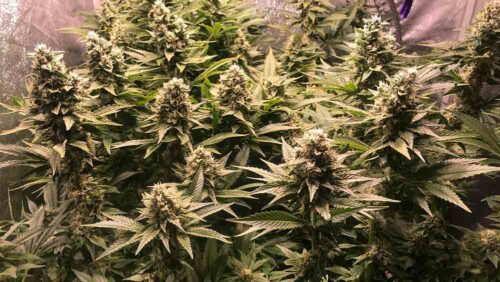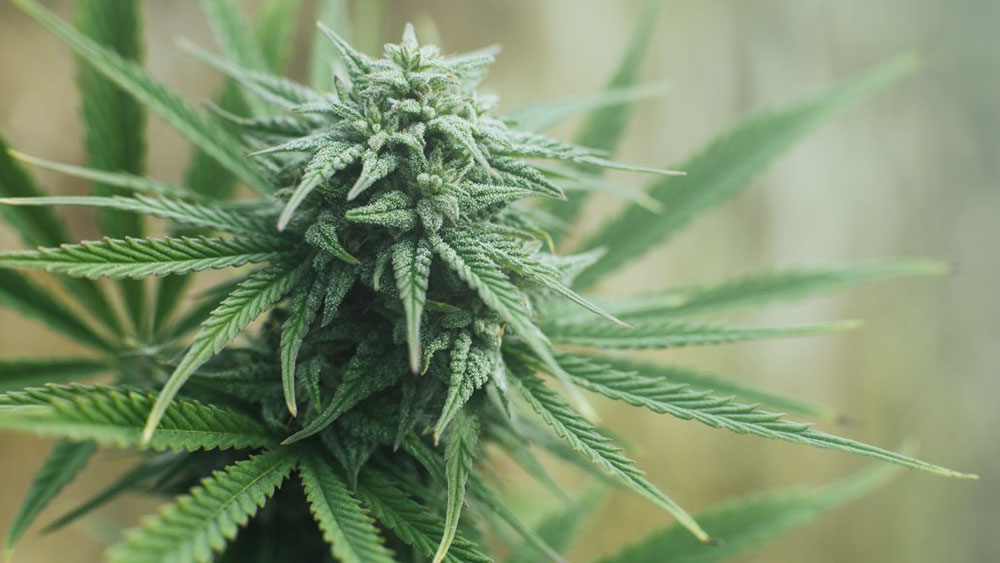OG Kush has been a household name in the world of cannabis for the last 20 years.
Ever since Dr. Dre’s “The Chronic” album, California has been on the lookout for ‘that loud’ weed. Sometime in the mid-’90s, OG Kush made its way to the underground scene.
There are two stories about how OG Kush first came about. The first story says that a breeder claimed he found the seed in a bag of Chemdawg 91 in the Lake Tahoe area in 1996.
The other one says that a grower from Florida crossed a male cross of Lemon Thai and Old World Paki Kush with a female Chemdawg.
For a while, OG Kush was a clone-only strain as seeds weren’t available. Growers used to hand out cuttings to other growers in order to keep the strain alive.
However, the strain didn’t need to be kept alive, it needed to be mass-produced. People loved it.
Soon after, medical cannabis got legalized in California and the rest is history.
Researchers, breeders, and many other scientists worked on replicating and improving OG Kush. Today we have many Kush strains that are stemming from the same OG Kush genetics.
As for its name, many assume it may mean Original Gangster or Original Kush due to its Cali roots—the truth is that the breeder himself named it Ocean Grown Kush, or OG for short.
The looks
OG Kush buds are very thick and dense.
They are very green with lots of orange hairs. OG Kush tends to have a lot of resin, which is why the buds will instantly stick to your fingers.

While growing it, OG Kush will have lots of buds appearing everywhere on the plant. The plant is short and bushy with big colas sticking out of the canopy like a porcupine.
OG Kush buds are very sticky and fat so you’ll definitely want to use a grinder.
The taste
OG Kush is known as one of the skunkiest, smelliest strains that are out there. Rappers like Snoop Dogg and his peers have been praising this strain for many years.
Users tend to describe the taste and smell of OG Kush as a very pungent, almost as if a skunk sprayed nearby. This is not a bad thing in the world of weed.
It also smells somewhat piney with a hint of lemon on the way out of your lungs, which is not something you can say for every strain.
The high
OG Kush is renowned for its strong cerebral effects. It will make you extremely relaxed and stress free.
Effects of OG Kush are long-lasting as this very potent hybrid is known for the longevity of its high. In high doses it causes serious dryness in the mouth and eyes, but you can counter that with some easy dry mouth remedies.
It can also induce mild paranoia in novice users, so take it easy the first couple of times.
Seeing how it comes with an average of 18% of THC, OG Kush is somewhat less potent than many of the strains that come from its lineage, however it’s still considered a potent strain.
The grow

OG Kush is known for being relatively hard to grow, especially for first-timers.
It flowers for about 8 weeks, although there are now versions of OG Kush out there that flower longer than that, even up to 10 weeks.
OG Kush has good genetics as far as yield and temperatures go, but it’s not very resistant to bud rot and mildew.
Seeing how the canopy can often grow quite bushy, you will need to trim OG Kush plants hard and often. If the leaves throw shade on the buds, bud rot is known to appear in mere days.
OG Kush is best grown in temperatures ranging between 18°C and 25°C (65°F to 80°F) and you should make sure the area isn’t humid.
It grows well in both soil and water, however, hydroponic OG Kush tends to have much higher amounts of THC, and it’s somewhat easier to control the conditions of the grow op.
OG Kush plants require heavy feeding, especially with CalMag, aside from other nutrients.
The yield is above average, although not the biggest out there — 400-500 grams per plant, or 1.6 ounces per square foot.
Applying a SOG and SCROG is strongly advised as all the flowers will need exposure to light so that they may yield more.
Given that OG Kush can be very leafy, you must vigorously trim the leaves from the stem during harvest. Otherwise, they might introduce too much moisture into your drying room.
Where to find OG Kush?
OG Kush is widely available. This strain has made users fall in love with it over and over again, and the retailers and local black market dealers have noted that.
OG Kush gave way for many other Kush strains to break out and make a name for themselves.
In Canada, OG Kush isn’t very popular amongst the licensed producers. However, its offspring is grabbing major attention.
As for the United States, OG Kush is popular on the West Coast way more than anywhere else.






smith July 10, 2019 at 6:52 am
The website Leafly says OG Kush is a hybrid of Chemdawg and Hindu Kush, but it also states “we can’t be sure because OG Kush first came from bag seed in the early ’90s.” DNA Genetics, who sells OG Kush seeds, says that it is a “bag seed from a Grateful Dead show.” If this is true, then there is no actual Kush genetics anywhere in OG Kush, or maybe there could be, but nobody knows because Chemdawg also has unknown genetics and is attributed to being discovered at Grateful Dead show in 1991 (hence Chemdawg 91). The seedbank Dinafem tells a similar story, also involving a cutting of Chemdawg when explaining how the “OG” got into OG Kush. Many competing theories exist as to what “OG” stands for, the most common two are “original gangsta” and ocean grown. Dinafem attributes the “original gangsta” meaning to the rap group Cypress Hill, but says that the ocean grown theory is more widely accepted by professional growers and more likely to be true. According to Dinafem, the ocean grown comes from a California grower named John who gave a cutting of Chemdawg to an LA-based grower named Putz, who crossed in a Lemon Thai/Pakistani Kush hybrid, and created OG Kush. The OG comes from someone telling Putz that his buds tasted mountain grown, his reply was “this Kush is ocean grown” and the rest is history. Taste and Terpenes The signature scent and flavor has been described as “an earthy pine and sour lemon scent with woody undertones,” also as a “deep pine smell which captivates the nostrils and might lead to you getting high just smelling it.” These descriptions lead one to assume that the strain would have elevated levels of limonene and pinene, it is also likely that it will have high amounts of myrcene since it is the most commonly found terpene in cannabis. Strain fingerprinting done by Steep Hill Labs confirms that myrcene and limonene are the two primary terpenes in OG Kush, followed by β-caryophyllene and then pinene. Both limonene and pinene are known to produce uplifting and euphoric effects and are likely a major reason for the sativa-like effects that some users report feeling from OG Kush. Myrcene can have a sedating effect that cannabis researchers think could be a major component in the couchlock feeling some users report from indica strains. The Reverend Dr. Kymron DeCesare, of Steep Hill Labs, has noted that “OG Kush is considered by most to be a strong couchlock flower at about 1.25 percent myrcene.” Is it an Indica or a Sativa? Again, this depends on who you talk to, and it may have a lot to do with the fact that there are over a dozen strains commonly sold on dispensary shelves which are actually just different phenotypes of OG Kush. Technically, different strains would have distinct genotypes, their own genetics which make them unique. If the genotype is the same, but there is a different physical expression, such as a taller plant or a plant that becomes purple, that is a different phenotype. The environment in which plants grow has a huge role in what their phenotype will be, for example, a phosphorous deficiency can stunt a plant’s growth making it appear more like an indica rather than taller like a sativa. Sometimes different phenotypes can also result in more than just physical differences, such as two Kush strains having radically different terpene/cannabinoid profiles. According to Dinafem, OG Kush is “75 percent indica and 25 percent sativa,” this would make it a pretty heavy indica, which many users would expect to give them a relaxing effect. Despite this, many OG Kush fans report that it produces sativa-like uplifting effects, which could certainly be true given the pure sativa Thai genetics crossed into the Lemon Thai Kush that is potentially a parent of OG Kush. Much of the discrepancy over whether or not OG Kush is an indica or a sativa may come from recent research which shows that we don’t really know what is a sativa, what actually is an indica and if those are even the terms we should be using. In my nearly six years working in the cannabis industry, I have come across 16 different OG phenotypes being sold on shelves next to other OG phenotypes, named differently and treated as different strains, with many patients and budtenders unaware they had the same genetics. First, of course there is OG Kush, and then in alphabetical order we have Alpha OG, Boss OG, Butter OG, Ghost OG, Khalifa Kush, Larry OG, Lee Roy (the only one without OG in the name), Legends OG, Presidential OG, SFV OG Kush, Skywalker OG, Steve’s OG (50/50), Tahoe OG Kush, True OG Kush, and Triple X OG Kush. I have also seen some of these strains, namely Butter OG and Skywalker OG, referred to as hybrids of other strains with OG Kush rather than a different phenotype, further compounding uncertainty. On top of the different phenotypes, there are the legion of OG hybrids, including numerous back-crosses, such as Fire OG, which is OG Kush crossed with an SFV OG Kush pheno. Like the Chemdawg which gave rise to OG Kush, there is more mystery than certainty. But, people do love a mystery, which may be one reason why it is one of the best-loved strains of all time. TELL US, do you smoke OG Kush?